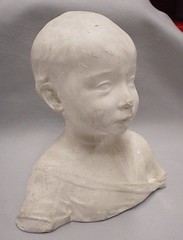For example: Yesterday I was going over an accession list for one of our collections (the list that was made of everything when it came into the museum). One of the items on the list was a bust by Desiderio da Settignano. I was skeptical. I doubted that we had a marble bust from an Italian Renaissance sculptor in the collection. But it's possible. Our collection, while small, is very diverse.
I hadn't encountered the object before, so I went to check on it. As I lifted it out of the back corner of the shelf it was on, I knew that it wasn't an original (it was far too light to be marble, and the inside was hollow); it was a plaster reproduction of A Little Boy.

Interestingly, none of the written documentation had indicated that this object was a reproduction. It was also mis-identified as a bust of the infant Christ. But a few minutes using google identified the original as residing in the National Gallery, and not being of an infant Christ, but an anonymous boy.
Now it's properly identified, and we have an issue in front of us: what do we do with this reproduction? It's not the real object, so it doesn't have the same intrinsic value (and I'm not referring to monetary value - the same would be true of a reproduction of a military uniform, or of a cereal box, for that matter) that the original would have. So do we keep it? If we don't keep it, what do we do with it?
I have my thoughts on this matter, but I'm going to keep them to myself. What do you think? How should museums handle reproductions (fakes) in their collections?
2 comments:
Well in some cases fakes can have their place, I think it really depends on the scope of the museum. An example would be the Acropolis museum which currently has reproductions of the Parthenon Marbles. Also the U. of Pennsylvania Museum of Archaeology and Anthropology has a large collection of reproduction bronzes of the bronzes that were found in Pompeii. This collection was made in the late 1800's and in itself has historical value even though they are reproductions.
This bust, however, seems to be on it's own (so not part of a collection) and doesn't seem to fit the scope of your museum (at least I don't think it does). It's hard to say what to do with this lonely reproduction. There might be a museum somewhere that might be interested, perhaps one that has a collection of the artist's work and would like to make its collection more complete even if it is with a reproduction. Good luck with it!
The Spurlock Museum here at UIUC also have reproductions of Greek friezes made in the 19th C. that have more detail than the originals which have deteriorated due to acid rain/exposure, etc.
Reproductions also make me feel that I'm in good stead with my professional ancestors. While I may work in a digital media, these kinds of reproductions show that surrogates have always been important for what museums do.
Post a Comment